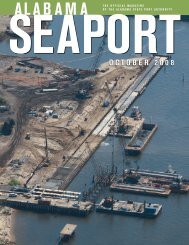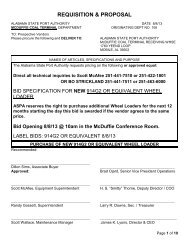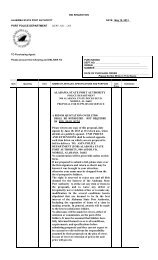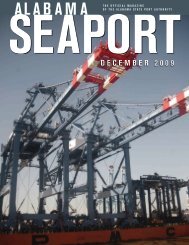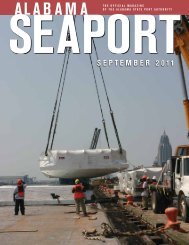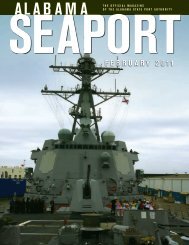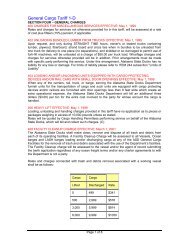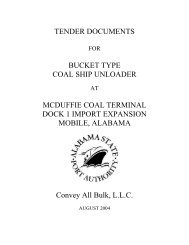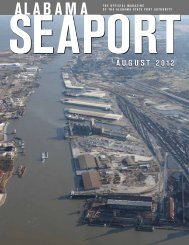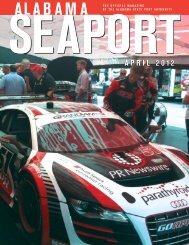June 2009 - Alabama State Port Authority
June 2009 - Alabama State Port Authority
June 2009 - Alabama State Port Authority
You also want an ePaper? Increase the reach of your titles
YUMPU automatically turns print PDFs into web optimized ePapers that Google loves.
Comprising less than two percent of U.S. Naval forces in the Pacific, the submarine<br />
service accounted for 54 percent of enemy tonnage sunk during World War II.<br />
rank of vice admiral) and named Commander in Chief, U.S.<br />
Pacific Fleet later that month, had spent his formative years in<br />
command of and overseeing the design of submarines.<br />
A 1905 graduate of the U.S. Naval Academy, Nimitz had<br />
been assigned to submarine duty with the First Submarine<br />
Flotilla in 1907, following a court-martial and letter of reprimand<br />
for grounding the destroyer USS DECATUR (DD-5). In<br />
May 1909, Ensign Nimitz took command of the flotilla, as well<br />
as the submarine USS PLUNGER (A-1). As a newly promoted<br />
lieutenant, he took command of the submarine SNAPPER<br />
(C-5) in February 1910 and was given command of the sub<br />
NARWAL that October, when he also became Commander,<br />
Third Submarine Division, Atlantic Torpedo Fleet. In November<br />
of the following year, Lt. Nimitz received orders to report<br />
to the Boston Navy Yard to oversee the fitting out of the USS<br />
SKIPJACK (E-1) as her prospective commanding officer. The<br />
boat was commissioned February 14, 1912. A month later,<br />
Nimitz personally rescued a sailor who had been washed<br />
overboard and was being swept away from the sub. Lt. Nimitz<br />
dove into the water and kept Fireman Second Class W.J.<br />
Walsh, who could not swim, afloat until a boat could pull both<br />
men from the water. For his heroics, Nimitz later received the<br />
Life-Saving Service’s (one of the forerunners of the Coast<br />
Guard) Silver Lifesaving Medal.<br />
Nimitz was gaining a reputation as an expert in the relatively<br />
new arena of undersea warfare. In 1913, he went to Germany<br />
and Belgium where he studied diesel engines. After serving<br />
as the executive officer on a tanker, Nimitz returned to subs,<br />
reporting to Commander, Submarine Force, U.S. Atlantic<br />
Fleet, first as flag aide and later as chief of staff. In September<br />
1918, Commander Nimitz reported to the Office of the Chief<br />
of Naval Operations and became the senior member of the<br />
Board of Submarine Design.<br />
After a tour as executive officer in the battleship SOUTH<br />
CAROLINA, Nimitz turned once more to the submarine service<br />
at Pearl Harbor, serving as commanding officer of USS<br />
CHICAGO and Commander, Submarine Division 14. Nimitz<br />
next reported to the Naval War College in Newport, Rhode<br />
Island, where he wrote a plan for naval warfare in the Pacific,<br />
which relied heavily on the use of submarines. Nimitz went on<br />
to hold a variety of commands over the next two decades, including<br />
commanding Submarine Division 20, Cruiser Division<br />
Two and Battleship Division One, among others, but it is fair<br />
to say that he knew better than most flag officers the potential<br />
offered by America’s submarine force.<br />
Nevertheless, the 21 submarines in the U.S. fleet on December<br />
7, 1941, were little prepared and ill-equipped for the type<br />
of duty that lay ahead of them. Unlike that of Germany, U.S.<br />
submarine doctrine called for torpedo attacks from depths<br />
well below periscope depth and using sonar bearings. Surface<br />
attacks, so skillfully employed by U-boats in the Atlantic<br />
and Caribbean, were considered far too risky. Pre-war guidance<br />
had also specified that submarines were not to surface<br />
within 500 miles of an enemy airfield, further hobbling subs’<br />
abilities to operate aggressively. In addition, the men commanding<br />
the boats typically were older, regular Navy men<br />
who were cautious in their approach to warfare.<br />
Further hampering the effectiveness of submarines in the early<br />
days of the war was the torpedo that the boats were supplied.<br />
Fleet subs were armed with the MK XIV torpedo, fitted with<br />
the MK VI “influence exploder,” which had seen limited field<br />
testing. From the outset, submarine commanders reported dismal<br />
results in the use of these torpedoes. The Navy, in typical<br />
bureaucratic fashion, responded that there was nothing wrong<br />
with the ordnance and that the problem most likely lay in human<br />
error.<br />
Shipping should never be a painful experience of bottlenecks and inefficiency.<br />
So when Hyundai, Honda, <strong>Alabama</strong> River Pulp and Babcock & Brown<br />
researched potential sites, they couldn’t ignore our ultra modern logistics.<br />
And <strong>Alabama</strong> couldn’t ignore the economic growth. asdd.com<br />
28 <strong>Alabama</strong> Seaport • june <strong>2009</strong> <strong>Alabama</strong> Seaport • May <strong>2009</strong><br />
29




